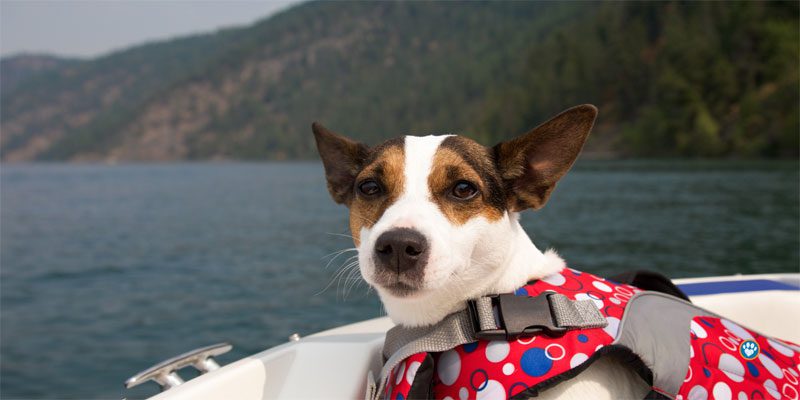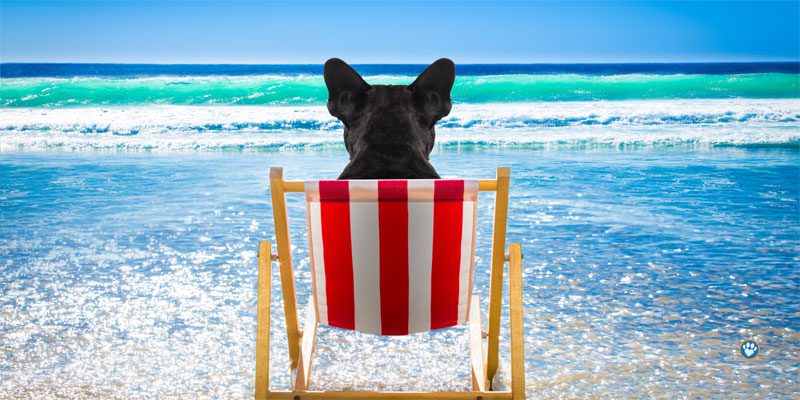Safety Tips For Boating Adventures With Your Dog.
Getting out onto the water is an activity which has seen significant growth in recent years. While people love to get out on the water on a boat, it is also an activity your dog dog might enjoy too. Whether you’re new to boating, or a seasoned sailor, Holidays4Dogs provides a few hints and tips on safely getting out onto the water with your dog.
There is something fascinating about messing about in boats. Whether you are paddling down river in a canoe, or meandering along the canal on a barge – boating draws many people to the waters edge. But, it’s not just people who enjoy the thrills and relaxation of boating – boating with your dog can add to the enjoyment of this relaxing pastime and many dogs enjoy the experience too.
Safety first.
Perhaps the most important thing to invest in if you intend to take your dog boating is a good life jacket. Not only are they essential for every person on board – your dog will definitely need one too. Life jackets do just that – save lives.
We like these EZYDOG DFD dog life jackets which are great for paddle-boarding and boating with your dog. Paddleboarding has soared in popularity and many people like to take their dogs along too.
It’s a good idea to take some time choosing a suitable paddleboard, as they must be stable enough to support your dog. We’ve done some research for you and found the IROCKER Cruiser Ultra which is one of the best compact SUP (stand up paddleboards) for taking along your pooch. It is super stable and has good deck pad space.
However, not all dogs are very good at swimming and some don’t like water at all. It is therefore important to make sure your dog is happy on the water and that his, or her, lifejacket fits well.
Sea dog sea legs.
Always start off very slowly and get your dog used to being near the boat. You may need to lift your dog onboard and provide lots of tasty treats. If your dog seems particularly anxious, it is important not to force things. Try again another day.
Remember, many dogs will just never get their sea legs. For extra safety when onboard, have your dog on a lead and attached to something secure. However, don’t have the lead too long, as this may cause a trip hazard to other boat users. In addition, never attach the lead to a neck collar – always to a jacket, or harness.
Calm waters.
You can also practice getting your dog used to go to his ‘station’. Particularly important on larger boats and river cruisers. Practice this on dry land before taking your dog onto a boat.
You can learn more about how to train this in our other Holidays4Dogs articles. Take a mat, which you can place in an out of the way spot. Encourage your dog to lie down on the mat while the boat is moving.
It is sensible not to allow your dog to move about on the boat while you are sailing. If your dog is particularly excitable, it would be safer to put your dog inside the boat while you are moving. In the case of narrow boating, keep your dog safe and secure while navigating through lock gates, as these can be particularly hazardous areas.
Sparkling water.
There is something very magical about the reflections created by the summer haze on oceans, lakes and rivers. However, as beautiful as it is to feel the cool of ocean spray under a summer sky, it can burn your skin much more readily.
Sun cream is another thing to consider if you intend to spend hot summer days on the water. The reflection of sun on water can cause skin to burn more quickly.
Apply sun block to your dog, with particular emphasis on tips of ears and noses. (They don’t need sun-block rubbing into their fur). Always to remember to carry plenty of fresh drinking water too. Don’t let your dog drink from the sea, lake or canal.
Swimming might be on the agenda depending where you are boating. However – while it may be refreshing and cooling on a hot summer day to take a dip – watch out for contaminated water, or strong currents.
Final thoughts on boating with your dog.
Some dogs may be very nervous and anxious about being on a boat, canoe, or paddleboard. If being afloat scares your dog and you are planning an extended trip, it might be kinder and safer, to leave them at home.
For many dogs, boating can be fun. Especially if it involves stopping at beauty spots, beaches and dog friendly pubs along the way.
Holidays4dogs.co.uk and 4Dogs are participants in the Amazon Services LLC Associates Program, an affiliate advertising program designed to provide a means for sites to earn commission fees by advertising and linking to the following websites. Read our full disclosure agreement here https://www.holidays4dogs.co.uk/affiliate-disclosure/





